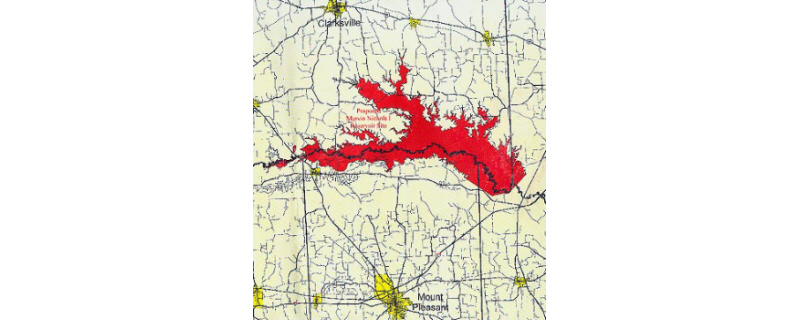~ by Brent Lawson ~
It’s the way we’ve always done it. A need for more water arises, and the government condemns a certain amount of low lying land to build a reservoir and quench the thirst. In 1913 Texas had four major reservoirs. Today there are over 190, providing over 5600 square miles of inland water. Texas leads the lower 48 states in fresh water resources. With that history it comes as no surprise that the recent urban growth in North Texas and the associated increase in water needs set wheels in motion to claim new reservoir land in five North East Texas counties to build the massive Marvin Nichols reservoir. It may be the way we’ve always done it, but that rationale isn’t sitting well with our neighbors in the Sulphur River Basin where family roots date back to the Republic of Texas.
It’s time to take a long hard look at the way we’ve always done things and give serious thought to the future of Texas water policy. It is an undeniable fact that the water problem is only going to grow as populations move and increase in the 21st century. The balance between water needs, water costs, and individual property rights need to be evaluated in proper context. Some things are difficult to put a price tag on, but that doesn’t relieve us of the responsibility to weigh the livelihood, the heritage, and the way of life, of our fellow Texans against higher urban water bills, finding alternative sources, or reducing demand.
There is growing confidence that the recent outcry over Marvin Nichols may allow the bullet to be dodged. Unfortunately, it isn’t a bullet, it’s a boomerang and postponing the project for now won’t keep it from returning in the future. The key to permanently solving the Marvin Nichols problem is to change the incentives so that alternatives become at least as attractive as seizing property through imminent domain. In 2005 the Texas Water Development Board completed a commissioned study into the feasibility of increasing the depth of existing reservoirs to expand water reserves. That study indicated that dredging is more expensive than creating new reservoirs, but it did not include estimates for cost sharing among other entities that benefit from the dredging. The study also left out the very real human costs associated with imminent domain property seizures. Dredging is currently done on some Texas lakes to improve water quality and recreation use. If we can value recreational boating, we should be able to value the heritage and property rights of our fellow Texans.
There are other technologies available for increasing the water supply. Waste water treatment, and desalination are currently in use in Texas. With increased use the higher costs of these technologies should come down. But as long as it is easy to simply take the land and build a lake, the incentive will not exist to pursue other options. Marvin Nichols represents an opportunity to begin to reestablish the value of our basic property rights, to help our neighbors in the Sulphur River Basin, to protect against future encroachments on the property rights of other Texas communities, and to start reshaping water policy for the 21st century throughout our nation.
On January 18th over 100 of us met in Cuthand Texas to learn about an entire Texas community with a unique culture and heritage that is destined for oblivion below the future waves of Marvin Nichols. In a congressional district covering 18 North East Texas counties this was a rare opportunity for our U.S. congressman to appeal to multiple grass roots organizations, bring 1,000 concerned citizens to show support, and make national news to start changing those incentives, and stop doing things the way we’ve always done them. Unfortunately, our U.S. representative didn’t find it vital to rally North East Texans and come to Cuthand that day. There are times and places where it is necessary to draw a line in the sand. In one such case the time is now, and the place is the Sulphur River Basin. Please contact your congressman and ask him to take a bold stand for property rights in North East Texas, or guarantee change by voting for new representation on March 4th.
Brent Lawson is an Electrical Engineering Manager and a 2014 Republican candidate for U.S. Congress representing Texas 4th District. www.Lawson4Texas.com
















